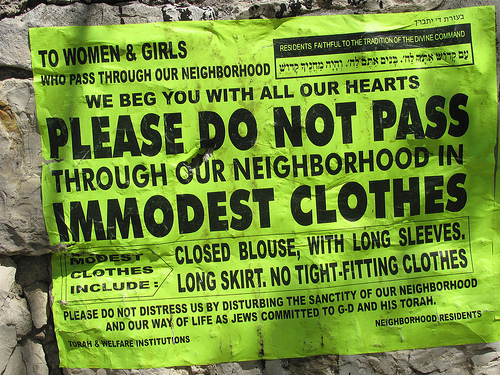
by Tara Bognar
Gangs of Meah She’arim

http://www.flickr.com/38440152@N06
Last week, a Meah She’arim gang that calls itself the Sikrikim assaulted a small group of Haredi girls, yelling and spitting at them for not being quite modestly dressed enough. (Helpfully, Yeshiva World lets us know that the “females” were appropriately dressed and thus, “the attack was without provocation and without justification.”)
A couple of hours later, relatives of the girls returned to the scene and beat up the young men responsible for the harassment. It turned into a brawl involving dozens of people.
Earlier this year, at the end of Sukkot, the Sikrikim glued shut the door of Gerrer Rebbe David Alter to prevent him from leaving the house for services. In retaliation, a group of Gerrer Hasidim boys and men chased down a Sikrikim leader and beat him bloody.
The Sikrikim named themselves after the Sicarii, an ancient Jewish guerilla organization that sought Jewish independence from the Romans and service to God alone, mostly by committing violence against fellow Jews that it perceived as collaborators. The media coverage I’ve seen (mainly English language orthodox and ultra-orthodox blogs), describes the modern-day Sikrikim as an independent group of somewhere between 20-100 young men.
Viewed from a distance, their actions do seem consistent with their namesakes: The Sikrikim have also made repeated attacks against an ice cream stand that facilitates men and women licking ice cream in public around each other and against a bookstore that includes English and pro-Zionist literature. In the past, they disrupted Egged bus service that they felt did not do enough to segregate men and women.
Viewed from a bit closer up, the whole thing starts to look like a proxy turf war between the Eida Haredit, an umbrella organization of Meah She’arim communities, and the Gerrer Hasidim, a large haredi sect that has not submitted to the Eida Haredit superstructure (Beit din, heksher, etc). Hotheaded, under-occupied young men have been persuaded that tantalizing acts of aggressive dominance that benefit the financial interests of their particular group also happen to coincide with God’s will.
Meah She’arim is tiny and Batei Warsaw is a tiny part of Meah She’arim. It was originally bought by a Polish philanthropist who arranged for housing in it to go to kollel families at very cheap rates. It has been largely occupied and controlled by the Eida Haredit. Over the last couple of years, members of the Gerrer Hasidim have been acquiring more and more of the housing, and, through their willingness to cooperate with political processes, control over the neighborhood committee as well. Among other things, they have been bringing more commercial enterprises to the area. The Eida Haredit has been feeling persecuted and pressured.
The Gerrer Hasidim accuse the Eida Haredit of physical attacks against individuals and businesses and attempts to extort ‘protection money’ from new local businesses. The Eida Haredit accuse the Gerrer Hasidim of using violent scare tactics, ‘pogroms’, to chase away current residents. It’s been going on for years. Finally, the Eida Haredit resorted to the normally anathema act of seeking assistance from secular courts whose authority they officially refuse to recognize.
The Gerrer Hasidim deny responsibility for the attacks against alleged Sikrikim leader Avraham Hirschman, and other members of Eida Haredit community. The Eida Haredit deny illegal activities and any ties to the Sikrikim, who are almost always described in the press as a rogue group. But spokesman and operations officer for the Eida Haredit, Yolish Krauss (sometimes Yoelish Krois), has been consistently been speaking up to defend the Sikrikiim. In a September operation against the Sikrikim, Israeli police arrested Krauss, along with another Sikrikim leader and a Neturei Karta leader. It was the Eida Haredit that printed posters condemning the beating of Avraham Hirshman while ignoring the violence perpetrated by the Sikrikim.
The whole thing is sad and people are being hurt, especially, as always, the vulnerable. The violence seems to only ratchet up the fundamentalism and there is more than enough reactionary feeling to go around. Still, in some ways it seems like more of a sociological phenomenon than a religious one. The combination of factors in Meah She’arim – underemployment, overcrowding, lack of resources, and lack of recourse to trusted law enforcement, represent an ideal growth environment for gang warfare. While couched in specifically Jewish religious language, the behaviors on display, including business extortion and the use of violence to enforce arbitrary customary behavior norms, are staples of urban history.